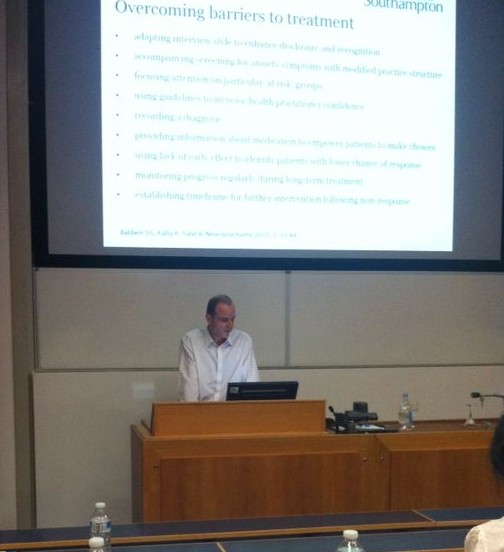On the 2nd September, we (that’s Ben and Nien) were lucky enough to join national and international investigators at ‘The Mechanisms of Menace’ conference to discuss recent advances in anxiety research.
Prof. David Baldwin and Dr. Matt Garner, both from the University of Southampton, organised an energetic one-day conference on anxiety that offered students, professors and clinicians from various fields of expertise the opportunity to share their experiences with colleagues, students and interested (/lost) bystanders.

Professor David Baldwin delivered an interesting and important talk from the academic psychiatrist*s perspective – about the recent changes to BAP guidelines, and how they might affect anxiety treatment/research
Professor Graham Davey from the University of Sussex kicked things off with an insightful assessment of the current state of affairs in anxiety research. While dancing around a self-professed proneness to ranting, a lot of what Professor Davey said was really in tune with the aims of EUSARNAD as a whole: while a lot of people with anxiety might only meet clinical psychologists and psychiatrists, there is a huge amount of research necessary to inform effective treatments – and it’s vital that clinicians and researchers learn from and inform each other effectively in order to develop and improve anxiety interventions.
This point was emphasized when Dr. Julie Hadwin spoke about her research looking at how improvements to basic cognitive processes (like working memory) could help adolescents with anxiety, and the morning session was rounded off by Dr. Lusia Stopa (Uni. Southampton) spoke about her research as a clinical psychologist, looking at how self-imagery could be used to improve social anxiety – exciting evidence of how laboratory experiments can have real world implications.

EUSARNAD member Nienke Pannekoek fielding questions on her work in the fields of comorbid anxiety and depression
Either side of lunch, a number of short, punchy talks explored the mechanisms of anxiety and anxiety interventions. Dr. Kate Button (Bristol University), Maria Ironside (Oxford Uni.), Dr. Ruihua Hou (Uni. Southampton), Michael Breen (Uni. Southampton), Annette Bruhl (Uni. Cambridge) and Nienke Pannekoek (Leiden Uni.) presented some really exciting work that used an amazing range of methodologies: from novel computer tasks to explore maladaptive cognitive processes in anxiety and using electrodes to stimulate specific brain regions [tDCS] to measuring cytokines and genetic predictors of psychopathology.
What was most striking was how all of the different presentations – each requiring a totally different expertise from the researchers! – fit together to help form a coherent understanding of anxiety. Dr. Sam Chamberlain (Uni. Cambridge) kept everyone interested after lunch discussing predictors of OCD.
The day finished with three talks that highlighted the themes of information sharing and collaboration – Dr. Matt Garner showcased the work that his group have been doing developing a new human-model of anxiety before Professor David Baldwin informed everybody about the changes that the British Association of Psychopharmacology had made to their guidelines for treating anxiety disorders. Lastly, Professor Elaine Fox (Oxford Uni.) gave an entertaining talk on the research she’s been leading investigating cognitive and genetic predictors of anxiety, and whether we can use these predictors to inform anxiety interventions.
Present throughout the day was Amo Kalar from AnxietyUK, a charity that works to support those with anxiety. Amo emphasised that in order to keep helping anxiety, collaboration must be used in conjunction with effective publicity; very much in line with EUSARNAD’s goals. He also had the honour of giving away awards for the two most outstanding posters of the day, by Denise Meuldijk (Leiden University, The Netherlands) and Kiri Granger (Uni. Nottingham).
The conference was a great success and after the day, both of us left feeling extremely motivated. It’s always the sign of a good conference when you leave with new energy, new ideas, new respect for other’s work, and lots of inspiration. It is exciting to see what the future will bring in the joint effort to target the menace of anxiety.
